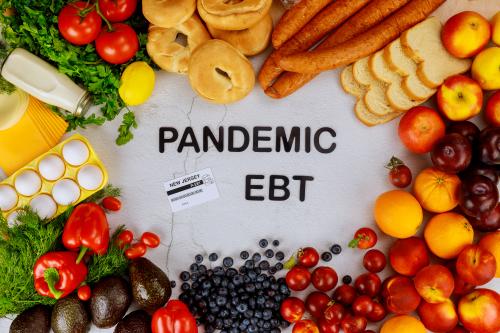Over the past 18 months, the United States experienced the most rapid economic downturn in its history and the most severe pandemic in more than a century. The novel coronavirus (COVID-19) has infected more than 42.8 million Americans with a death toll exceeding 687,000 people. The pandemic has caused a loss of life, livelihoods, and a way of life: child care facilities and schools closed their doors and millions of parents became full-time caregivers and teachers. In the spring of 2020, 55 million school-age children were out of school or navigating remote learning. In the 2020-21 school year, most children in the U.S. lived in a place where schools were closed.
Families responded to these challenges by relying on community resources and safety net programs, including for resources to purchase and acquire food. Supplemental Nutrition Assistance Program (SNAP; formerly the Food Stamp Program) caseloads increased about 19 percent between February 2019 and June 2021. In the fall of 2020, more than one in every ten dollars spent at the grocery store was from SNAP or Pandemic EBT. Many people used food pantries or received other forms of direct food assistance from a community or religious organization to stock their cupboards. Other supports for families, including Unemployment Insurance, the Child Tax Credit, Economic Impact Payments, and the rental eviction moratoria reduced poverty and/or food hardship.
Congress moved to support child nutrition in the wake of the pandemic by authorizing a new program, Pandemic EBT. This program provides families with an electronic debit card to purchase groceries for the value of the school meals missed due to pandemic-related school closures for the end of the 2019-2020 school year, the 2020-21 school year, and, in some states, the summer of 2021. The American Rescue Plan Act authorized Pandemic EBT for any school year in which a public health emergency is in effect, including the 2021-22 school year and the summer of 2022 (though no state is currently implementing the program, except retroactively). If schools were to close, states would be able to submit a plan to USDA immediately.
In this piece we offer a preliminary analysis of the effect of the Pandemic EBT program on food hardship to date. Building on our previous work evaluating the effect of Pandemic EBT during the first year of the program (the 2019-2020 school year), we leverage variation in the timing of Pandemic EBT disbursements across states from November 2020 through July 2021 to identify the effect of Pandemic EBT on SNAP-participating households with school-age children. (For more information on the research method, please see the technical appendix.)
We find that in the 2020-21 school year, Pandemic EBT:
- Reduced the share of families in SNAP households where children experienced very low food security by 17 percent;
- Reduced food insufficiency among SNAP households by 28 percent; and
- Had the largest effects in alleviating food hardship in states with relatively high rates of school closures due to COVID-19. In these states, Pandemic EBT reduced child very low food security by 22 percent and household food insufficiency by 39 percent.
This new evidence of the effect of Pandemic EBT’s implementation for the 2020-21 school year is consistent with our research on its effect following the 2019-20 school year, experimental evidence of the effect of Summer EBT, and evidence of the effect of additional SNAP resources in combatting food insecurity during economic downturns. This program should continue to serve as a safety net for children when schools are closed and be made permanent for summer months.
Measurement of food hardship and sensitivity to policy changes during COVID-19
The Census Bureau has been collecting data on material hardship in near-real time during the Coronavirus crisis through their experimental Household Pulse survey. In this survey, respondents are asked to assess the state of food available in their households. The Pulse measure of food insufficiency appropriately captures real-time food hardship during the pandemic and is able to identify the effect of resources to households on these measures.
Figure 1 shows the share of adults overall and those with children who report that they sometimes or often did not have enough to eat in the last week (“food insufficiency”) from April 2020 through August 2021. The figure includes vertical lines to indicate the timing the SNAP maximum benefit increase and the passage of the American Rescue Plan Act, both of which coincide with the authorization and/or disbursement of Economic Impact Payments, as well as the first monthly disbursement of the Child Tax Credit in mid-July. There were sharp drops in reported food hardship coincident with the disbursement of these resources. In addition, our initial Pandemic EBT analysis, which found that measures of food hardship decline in the weeks after a Pandemic EBT payment is made, shows that the measurement of food hardship in the Pulse is sensitive to changes in the economy or policy environment at both the national and state levels.
 Evaluating the causal effect of Pandemic EBT
Evaluating the causal effect of Pandemic EBT
Pandemic EBT is a social insurance program that functions similarly to SNAP: families receive benefits on an EBT debit card, which can then be used to purchase food at most grocery stores. If all schools were closed and all states were participating, approximately two-thirds of school-aged children are likely eligible for a Pandemic EBT payment, about 63 percent of whom are also enrolled in SNAP. Households already participating in SNAP received additional money on their EBT cards while other eligible households were issued new EBT cards loaded with the value of missed school meals.
The Pandemic EBT program was passed as part of the Families First Coronavirus Response Act in March 2020 to provide nutrition assistance to families who lost access to school breakfasts and lunches as a result of school closures. The program was initially reauthorized for the 2020-21 school year in October 2020. In December 2020, Congress simplified the program to expanded eligibility to younger children, as intended in October. The American Rescue Plan Act authorized Pandemic EBT in any school year and subsequent summer in which a public health emergency was in effect.
Every state and territory eventually submitted a plan to and received approval from USDA to implement Pandemic EBT for the 2020-21 school year. As Gupta, Gutierrez, Pratt, and Waxman of the Urban Institute show, states implemented 2020-21 school year Pandemic EBT starting at different times, to different populations, in different amounts, on different schedules. This interim analysis will not deal with all of the policy-relevant ways in which the program differed across states as intended and as implemented across states, including variable dollar amounts across and within states and different disbursement schedules (with different disbursement amounts). We address these cross-state differences by evaluating the effect of Pandemic EBT for the 28 states with particularly high state-wide school closure rates. In future work, we will explore these policy and implementation differences across states with more precision, as well as extend the analysis to students who were not receiving SNAP benefits.
Relevant to this analysis, states varied in how much time it took to develop a plan for how to implement Pandemic EBT, gain approval from USDA, and begin disbursing benefits to households who were already participating in SNAP (figure 2). Families that were already enrolled in SNAP did not have to apply for the program and typically received Pandemic EBT benefits in a state’s first disbursement. There is substantial and idiosyncratic cross-state variation when states issued their first Pandemic EBT payments to these households: four states made initial payments in December 2020 or January 2021, seven in February, ten in March, four in April, and the remaining half of states in May 2021 or later.

For this analysis, we created a database that captures the first date that Pandemic EBT payments went to SNAP-participating families in each state, as well any later dates states made disbursements to SNAP households. We combine this information with the Census Bureau’s Household Pulse Survey (HPS), a household survey conducted frequently since late April 2020 that asks respondents about their household’s economic, health, education, and food insufficiency, allowing us to identify the effect of policy changes across the country over time. In order to examine how Pandemic EBT has affected families’ food hardship, we leverage variation in the timing of Pandemic EBT disbursements and look at weekly changes in food hardship across states before and after a state issued Pandemic EBT payments from November 11, 2020 to July 5, 2021.
We estimate the impact of Pandemic EBT on two outcomes: whether parents reported that the children in the household don’t have enough to eat (very low food security among children) and whether parents reported that it was sometimes or often the case that there is not enough food in the household (food insufficiency). We estimate the effects of having received Pandemic EBT prior to the survey week; for weeks in which Pandemic EBT was disbursed, we adjust the estimated effect of Pandemic EBT by the share of days in the survey period following Pandemic EBT disbursement. We also control for other factors including respondent age, race/ethnicity, education level, marital and employment status, the number of children in the household, state and week fixed-effects, the disbursement of SNAP Emergency Allotments (which vary by week and state), and the receipt of other free school meals.
Effects of Pandemic EBT on measures of food hardship
In our evaluation of Pandemic EBT from 2020, we identified program effects on households with school-age children and 2019 income below 130 percent of the federal poverty line (to approximate SNAP eligibility) as the treatment group. Because of the way that income data are collected and the need to assume take-up among eligible households, this method imperfectly captures the treated group (see the technical appendix for a detailed discussion).
We replicate that analysis here for transparency but make two changes that improve our identification of households that received Pandemic EBT benefits during the 2020-21 school year. Because later Pulse survey instruments ask directly about SNAP participation, we show the effect of Pandemic EBT for families who report SNAP receipt for the 2020-21 school year. Second, because state plans for Pandemic EBT disbursement and school closures were not uniform across the country, we show our results for SNAP households both for all states and for the 28 states that had particularly high school closure rates (states that are crosshatched in figure 2). For additional details and robustness checks, please refer to the technical appendix.
Figure 3 shows the effect of Pandemic EBT on household food insufficiency and very low food security among children; the findings for SNAP households (purple) are our focal results. We show 2020-21 school year results overall and then among the 28 states that reported particularly high levels of school closures. We also show the results from our prior work from the summer of 2020 (teal) for completeness.

Figure 3 shows how receipt of Pandemic EBT affects food hardship among low-income households and SNAP recipients with school-age children during the COVID-19 crisis. We find that targeted food assistance payments through the Pandemic EBT program, designed to provide funds to replace missed school meals, significantly reduced food hardship in the winter, spring, and summer of 2020-21, measured by both the share of families where children experienced very low food security and the share of families reporting sometimes or often not having enough to eat. These estimates are somewhat lower than estimates from the summer of 2020 (teal bars) for VLFS-C and larger for food insufficiency.
For the SNAP population, those who were most likely to have received the Pandemic-EBT “treatment,” overall Pandemic EBT reduced very low food security among children by about 5 percentage points (about 17 percent) and the share of families reporting sometimes or often not having enough to eat by 7 percentage points (28 percent). Moreover, the reductions in food hardship are larger in areas where school was conducted remotely for most of the school year: in these states, Pandemic EBT reduced the share of families reporting sometimes or often not having enough to eat fell by 10 percentage points (39 percent) and the share of families where children experienced very low food security by about 6 percentage points (28 percent). These patterns are consistent with Pandemic EBT’s objective to fill unmet need due to school building closures.
Conclusion
Pandemic EBT continued to help families avoid food hardship in the second year of the COVID-19 pandemic. Our results point to the social insurance benefit of this program for low-income families, especially those who are receiving other forms of income assistance. Pandemic EBT significantly reduced the share of families in SNAP households where children experienced very low food security and significantly reduced food insufficiency among SNAP households. Pandemic EBT was especially impactful in states with relatively high rates of school closures due to COVID-19, as access to prepared meals diminished and school-closure-related economic consequences affected families.
Currently, federal policy is to provide prepared meals for free to eligible students over the summer through the Summer Food Service Program and Pandemic EBT is authorized for the summer of 2022. Congress is considering a proposal to make the program permanent for eligible families during summer months from 2023 through 2030. Having worked through many of the implementation challenges in implementing Pandemic EBT, and with more clear eligibility criteria and disbursements amounts, Summer EBT could roll out consistently across the U.S. in the future. Along with the overdue modernization to the Thrifty Food Plan, the continuation of an EBT strategy that provides resources to purchase food for eligible families with children when schools are closed could provide similar benefits.
Federal child nutrition policy over the past year in conjunction with the Summer EBT proposal before Congress comports with what we argued for in the lead-up to the initial authorization for Pandemic EBT: when schools are closed, EBT benefits “could be a mechanism to provide resources to purchase food at time of predictable (summer) and unpredictable (emergency) need.”
The Brookings Institution is financed through the support of a diverse array of foundations, corporations, governments, individuals, as well as an endowment. A list of donors can be found in our annual reports published online here. The findings, interpretations, and conclusions in this report are solely those of its author(s) and are not influenced by any donation.
-
Acknowledgements and disclosures
The authors thank Eliana Buckner, Ronnie Clevenstine, Moriah Macklin, Emily Moss, Abigail Pitts, Elisabeth Raczek, Beatriz Rivera, Natalie Tomeh, Jennifer Umanzor, Sarah Wheaton, and Winnie Yee for exceptional diligence and research assistance over the course of this project. We are grateful to Raheem Chaudhry, Sheila Fleischhacker, Hilary Hoynes, Zoë Neuberger, Dottie Rosenbaum, and federal and state officials for sharing program implementation information with us. We are grateful to Kristin Butcher, Wendy Edelberg, Poonam Gupta, Emily Gutierrez, Joseph Llobera, Dottie Rosenbaum, Elaine Waxman, and participants at the Association for Education Finance, Policy and American Society of Health Economists, NOPREN working group, and Economic Studies at Brookings seminars for providing feedback on this work. The views expressed in this piece are the authors’ alone.









